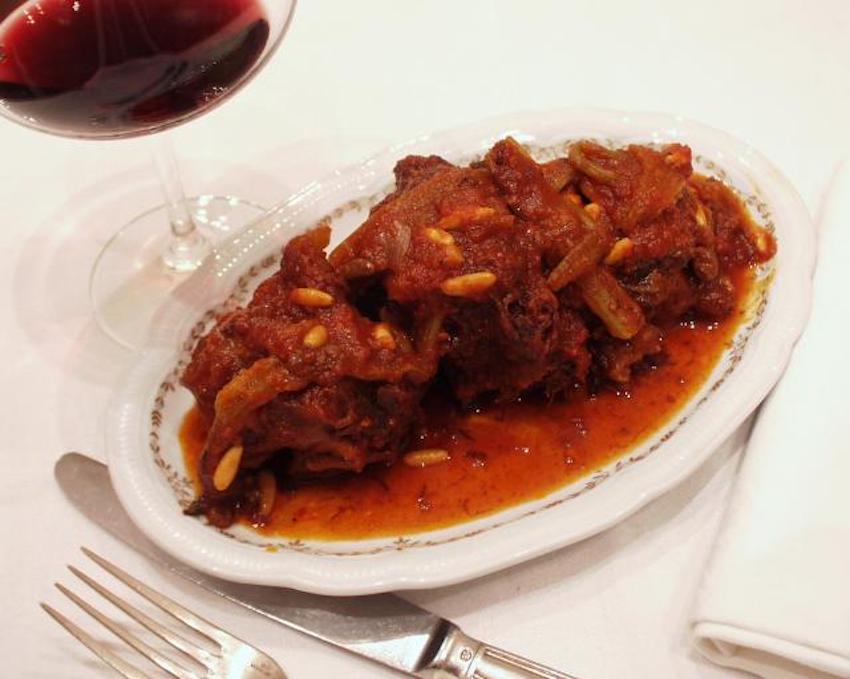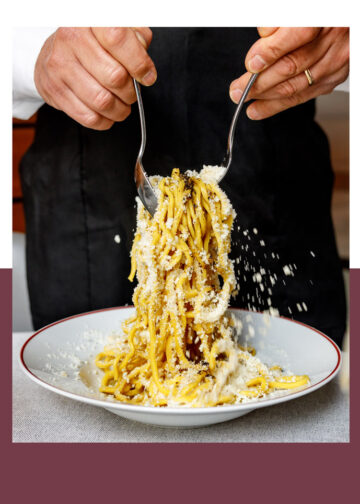From the ancient Romans we’ve inherited the basis for modern civil law and city planning, a standard coinage, a system of weights and measures, plumbing, aqueducts, bridges, …and delicious food, represented best by pasta especially spaghetti alla carbonara or cacio e pepe, gnocchi, saltimbocca, innards (the apex of authentic Roman cuisine), stuffed zucchini flowers, supplì (fried rice balls stuffed with mozzarella), pecorino cheese, and artichokes.
The world’s first recorded gourmets, alias buone forchette, owe their obsession with food, at least in part, to fellow citizen Marcus Gabius. Better known as Apicius, he was a wealthy and decadent epicure who in the first century wrote De Re Coquinaria (Concerning Culinary Matters), the world’s first cookbook. He specialized in spicy sauces and cakes and held extravagant feasts for his friends, in particular the emperor Tiberius’ son, at his seaside villa at Minturnae between Rome and Naples.
Alas, when he’d blown most of his fortune, Apicius poisoned himself, afraid to die of hunger. After Apicius’s suicide, De Re Coquinaria was copied and re-copied. The oldest two surviving manuscripts are in the Vatican Library and in the New York Academy of Medicine.
Although many of Rome’s some 5,000 bustling, clattery trattorie serving Roman specialties are family-run, only Checchino dal 1887 has belonged to the same family for so long, five generations so far. The restaurant is carved into the man-made Monte de’ Cocci, a hill of discarded broken amphoras from Rome’s nearby port.

Brothers chef Elio and sommelier Francesco Mariani specialize, although not exclusively, in dishes using the quinto quarto or fifth quarter—offal, tripe, intestines, and oxtail—originally discarded or used as part of the workers’ salaries at the slaughterhouse across the street which closed in 1975. In fact, coda alla vaccinara (oxtail braised with tomato and celery), now a classic of modern cucina romana, was invented here. Also, always on the menu are: rigatoni con pajata (pasta with baby-calf intestines), animelle (sweetbreads), coratella con carciofi (chopped lamb heart, liver, lungs, and windpipe with artichokes), and trippa (tripe) cooked with wild mint and tomato.

Another dynastic eatery of Roman cuisine is Felice, owned by the Trivelloni family since 1936. Like Checchino dal 1887, it’s located in the once working-class turned chic neighborhood called Testaccio named for the Monte de’ Cocchi. Felice’s star dish is tonnarelli al cacio pepe, whisked at your table. Present owner Franco, Felice’s son, has posted its recipe on the restaurant’s website. A favorite of the world-famous actor Roberto Benigni, be sure to book (obligatory) at least five days in advance. In addition to the standard menu, Franco and his son Maurizio have an additional separate menu for each day of the week. The Romans traditionally eat fish on Tuesday and on Friday, gnocchi on Thursday and tripe on Saturday.
Still another dynastic homage to Romanity through its cuisine is Sora Lella, founded in the 1950s by the short, plump, exuberant, comic actress Elena Fabrizi with her much more famous and even shorter and plumper gourmand comic actor older brother Aldo. The children of a widowed fruit vendor in Rome’s historic food market in Campo de’ Fiori, they considered their acting careers a hobby and their true profession restaurateur and gastronome.
Located on the Tiber Island, the only island in Rome, it’s across from the ancient port. Since 293 BC, when a temple was dedicated here to Aesculapius, the god of healing, there’s always been a hospital.

After Sora Lella’s death in 1993, her disciple and son Aldo Trabalza took over. Now Aldo’s four children, so the third generation, run the restaurant. His sons Mauro and Renato, who learned Nonna Lella’s recipes hands-on in the 1980s, are the chefs. Their mouth-watering starters include supplì, artichokes deep-fried Jewish style, and potato croquettes. The menu includes all the classic “Roman” quinto quarto pastas, even some for celiacs. But the house specialty, on the menu since 1961, is homemade tonnarelli alla cuccagna. With 18 different ingredients in the sauce–bacon, sausage eggs, and walnuts and more—it’s a must as are Renato’s homemade ricotta cake with wild cherry sauce and his gelati. Available on the internet, Sora Lella’s Annamo Bene recounts her life and cuisine with recipes and Aldo Trabalza’s Il mio amico l’albero di fico, the family history.
Like Felice and Sora Lella, Armando al Pantheon, founded in the 1960s, is in its third generation of the Gargioli family ownership. Just across the street from the Pantheon, the best preserved of all ancient Rome’s buildings, Il mondo sta tutto in cucina: buon cibo e buona scrittura fanno felicità by present-owner Claudio recounts the family’s history. Reservations are available only online and only a month ahead of your desired meal, so, in bocca al lupo.
To these all-in-the-family classics, don’t overlook the newer entries. Trecca and Osteria Fratelli Mori are also both in Testaccio, and newest of all (opened November 2023), Casa Sceppa, a 10-minute walk from St. Peter’s Basilica.












